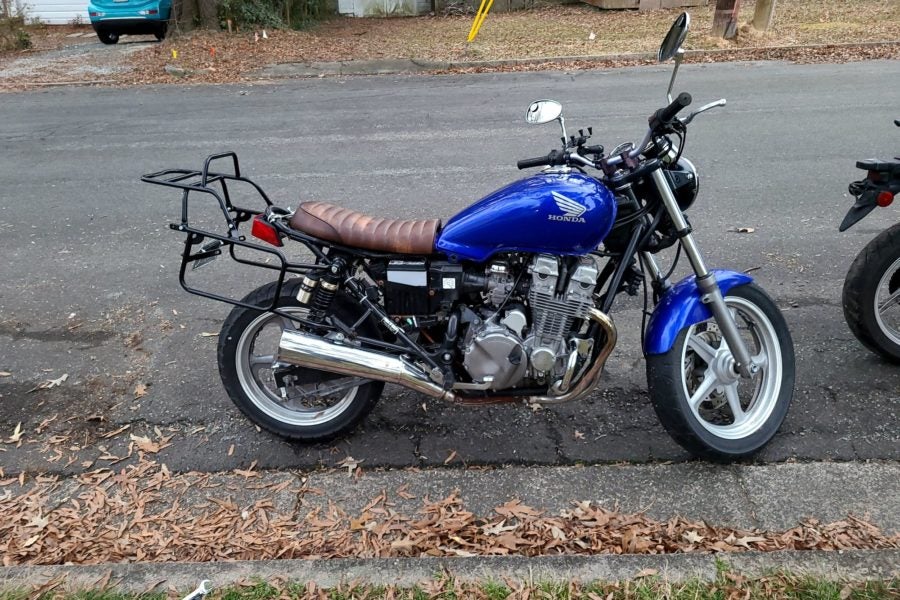Retro machines are a huge market these days, with motorcycle buyers looking backward as keenly as they look forward. This has always been somewhat true of the parallel twin and V-twin markets, but retro inline fours are also hot stuff right now (see also: Kawasaki Z650 RS plans).
It’s true that the retro market has been particularly hot for the past decade or so, but nothing is new under the sun. Way back in the 1980s, Honda had the GB500 as an homage to Brit cafe bikes. In the 1990s, Big Red tried again, with the Nighthawk 750, a kinda-sorta homage to the days of air-cooled Universal Japanese Motorcycles—with the original UJM series just disappearing off showroom floors a few years earlier.
A classic formula
Although the Nighthawk 750 was considered a “modern UJM” when it appeared in 1991, you could almost consider it the evolutionary pinnacle of the air-coooled CB lineup. It wasn’t exactly a retro bike that was held back by using long-dead tech. Really, it was a bike that took the previous generation’s technology to its ultimate conclusion in a budget bike package. Sort of.
The Nighthawk wasn’t the heir to the original 1969-vintage CB750. That machine was a superbike, perhaps the best streetbike in the world at its debut. The 1991 Nighthawk bore the CB750 badge in some markets, but it was really descended, practically speaking, from the CB750 (or CB700, in the US market) and CB650 Nighthawk models of the early 1980s.

Brochure cover for the 1984 Honda Nighthawk 650. This was more of a custom-styled bike, and the Nighthawk 750 for that era (or Nighthawk 700, for US customers) was more of a sporty machine. The ’90s version split the difference, as far as styling went. Photo: Honda
Those bikes weren’t the hottest stuff on the street, even when they debuted, but they were reckoned to be very sensible all-rounders, with shaft drive and hydraulic valve lash adjustment that meant riders could focus on riding, not wrenching.
Same for the 1991 Nighthawk 750. Like those bikes of a decade earlier, it had an air-cooled DOHC inline four engine, with 16-valve head. It made about 75 horsepower at 8,500 rpm, and 47 pound-feet of torque at 7,500 rpm. Those aren’t big numbers, but they’re enough to grossly exceed any posted speed limit in the world in 1991, or today.
As this was the 1990s, the Nighthawk drank fuel from a set of 34 mm Keihin carburetors. The voodoo of EFI was still a generation away for bikes in this segment. The front brake had a two-piston caliper and 316 mm disc, and there was a drum setup in back, with no ABS available. Again, pretty humdrum stuff, even at the time of its debut. You could say the same for the steel twin-downtube frame and 41 mm air-assisted forks, or the dual rear shocks, which were only preload-adjustable. It was all ’80s tech, repackaged for the 1990s.
At 474 pounds dry weight, the Nighthawk was a bit on the chunky side, too.

The 1990s version of the Nighthawk ditched the shaft drive in favour of a chain drive. This kept costs down, but also removed one of the bike’s most appealing features.
With all that in mind, the jaded bike journos of the early 1990s were not exactly keen on the Nighthawk. Who wanted to ride a stodgy old UJM with middling performance, when the magazine garage had a shiny new Kawasaki ZX-11 begging for a flogging northwards on California Route 20? Even today, when the bike writers talk about the Nighthawk 750 (at least the US-based writers), they’ll often damn it with faint praise.
However, the Nighthawk is still considered a cult bike, with owners undeterred by lackluster reviews. That’s because, at this point in 2021, these people didn’t buy their 750 expecting razor-sharp handling, powerful brakes, or a muscular engine. They wanted long-term rideability, and the Nighthawk had plenty of that to offer.
First, there’s the hydraulic valves. The engine is practically maintenance-free. Make sure you keep up on the oil changes, and you’ve got little to worry about. Unfortunately, Honda cheaped out and went with a chain drive on this bike, instead of the shaft drive as seen on the originals, but at least you won’t find replacements unobtanium, if you have any trouble with it.
The seat is comfortable and low, at 30.9 inches. The 4.7-gallon tank has plenty of range, and if you do have to work on something, all the mechanical are readily accessible.
And, it looks like a real motorcycle made for the real world, not a hunched-over crotch rocket aimed at wannabe Ricky Racers. You could commute to work on one of these machines, or ride across the country, in comfort.

Here’s what @TomCFitz’s bike looked like when he bought it, before building his custom luggage rack.
The Nighthawk 750 today
The trouble is, 30 years after its debut, any Nighthawk 750 is getting a bit rough around the edges. That means prices for a used bike will drop, and that’s a good thing. But, used prices mean they get in the hands of cafe racer enthusiasts and other builders, and that can go either way.
The example seen here is being sold by inmate @TomCFitz. It’s bodged up because, as he puts it, “the previous owner did a half-assed cafe conversion to it.”
His response? Take a lemon, and make lemonade: “Since its still a sport-tourer at heart, I felt it needed some racks and panniers so I can carry my stuff around.” You can see a write-up of his fabrication process here.
The bike itself seems in relatively good nick, despite the “half-assed cafe conversion.” Seller @TomCFitz says “Recently (around 30k miles) I had the forks rebuilt, including the bushings and new springs, new tires (Pirelli Sport Demons, though the front has a plugged hole since mile 50, no leaks or anything, you can’t even really see it anymore.).” He was asking $2,500, but now he says he’s open to negotiation. See more details at the bike’s ad here.







